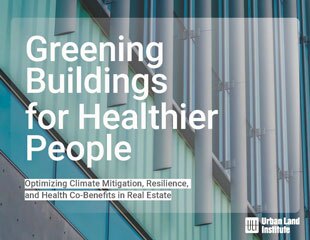ULI’s Building Healthy Places Initiative published the report Greening Buildings for Healthier People: Optimizing Climate Mitigation, Resilience, and Health Co-Benefits in Real Estate in March 2022. This three-part article series takes a closer look at some of these co-benefits and how they can promote project success locally while contributing to healthier cities, regions, and beyond. Part I: Exploring the Benefits of Low-Carbon Buildings for Climate Change and Health | Part 2: Exploring the Benefits of Transportation-Related Amenities for Climate Change and Health
Throughout the COVID-19 pandemic, many urban residents sought safe, outdoor places to gather and enjoy nature. From pocket parks to waterfronts, these green spaces not only helped to prevent viral transmission but also contributed to people’s health in a variety of ways: providing a space in which to exercise, enabling people to socialize and connect, serving as a cool place during hot days, and delivering the mental health benefits of nature, among other benefits.
However, not all neighborhoods have easily accessible and welcoming green spaces. Building owners can help to remedy these inequities by opening green spaces on their properties to the public, thereby extending these benefits from their tenants to the wider community. At the same time, high-quality green spaces create value for the property (as does incorporating nature indoors, such as using biophilic design elements).
ULI recently published Greening Buildings for Healthier People: Optimizing Climate Mitigation, Resilience, and Health Co-Benefits in Real Estate, which includes strategies for promoting access to nature at the property scale and describes the wide-ranging benefits of doing so. Although the report focuses on these strategies’ benefits to tenants, communities, and project success, “greening” the building—both inside and throughout the site—also helps shape the larger urban environment.
For example, green spaces can mitigate flooding and extreme heat locally, which prevents combined sewer overflows and other issues that would affect the entire city. This is an especially important consideration for the more than half of U.S. buildings that are in disaster hot spots. Between 2005 and 2018, sea-level rise flooding cost $14.1 billion in home values across eight states’ coastal areas, and cities will experience the economic repercussions of this damage as well.
Increasingly, access to nature is no longer seen as a “nice-to-have” feature, with tenants, communities, and cities recognizing its essential benefits. As real estate professionals aim to optimize the climate and health co-benefits of embedding nature in their properties, they can harness the strategies below while also considering the potential for a broader—if less direct—impact in their cities.
Optimizing the Many Benefits of Access to Nature
The report discusses access to nature in terms of outdoor green spaces, biophilic design, and materials selection, all of which have co-benefits for climate mitigation, resilience, and/or health.
Outdoor Green Spaces
Outdoor green spaces range from small courtyards to entire parks. Strategies include:
- Installing green stormwater infrastructure (GSI). GSI helps to mitigate flooding, provide shade, lower outdoor temperatures in the immediate area, and reduce the need for excessive air conditioning in the building, which would then increase energy usage and create more waste heat. It can also serve as an outdoor green space, which enhances the public realm, provides a place to recharge, and enables people to enjoy the mental health benefits of nature.
- Creating green roofs. Green roofs make buildings more resilient to extreme heat, and when used as accessible outdoor spaces, the vegetation can help with flooding while creating natural spaces that reduce stress and have positive mental-health impacts. Additional climate mitigation benefits arise from the co-benefit of a more insulated roof as well.
- Hosting bees on site. Bees can enhance climate resilience by supporting local biodiversity. According to The ULI Blueprint for Green Real Estate, “Biodiversity provides ecosystem services that are vital for the real estate industry, including stormwater management, microclimate regulation, air quality improvement, greenhouse gas sequestration, plant pollination, and recreation. In urban areas, biodiversity has decreased because of building on top of green space, population increases, and global warming.”
Biophilic Design
Bringing nature inside can also provide benefits to tenants. When buildings use a biophilic design, the plants can, to an extent, improve air quality, and the natural elements can help to reduce stress and improve cognitive functioning. Biophilic design strategies include:
- Interior architecture, architectural finishes, artwork, and furniture that reference and/or mimic patterns found in nature;
- An indoor atrium, terraces, or courtyards;
- Live and healthy plants; and
- Natural light.
Materials Selection
Building materials can not only serve as part of a biophilic design but also reduce embodied carbon by enabling developers to use fewer materials or low-carbon ones. Strategies include:
- Choosing materials that act as natural elements in a space. One example is timber beams that are left exposed as part of a biophilic design; these also sequester carbon throughout their lifetime.
- Using cross-laminated timber (CLT). CLT not only offers biophilic design benefits and reduces embodied carbon but also performs better seismically than traditional building materials, can maintain structural integrity during a fire, and can be designed for wind resistance.
Advancing Project Success
These strategies often have direct financial benefits. For example, some projects may be able to receive tax credits and other incentives for installing green stormwater infrastructure. And, by making buildings more resilient, owners are able to reduce or avoid costs from relocation and rebuilding.
Plus, meeting tenant demand for nature-infused designs and outdoor spaces can help with project marketing. In office settings, promoting healthy workspaces can result in lower healthcare costs and help to retain tenants that see improvements in wellness and productivity.
These strategies can also help developers and owners work toward building certifications for both sustainability and health, such as LEED, WELL, and Fitwel. (See the report for additional information on certifications.)
Climate and Health Impacts Beyond the Building
In addition to the many benefits above, these strategies can also be leveraged to enhance climate mitigation, resilience, and health in the community and city.
When outdoor green spaces are publicly accessible, they can contribute to a sense of social cohesion in the broader community, which helps to build connections and social resilience—key components of both health and climate resilience.
Of course, these green spaces come with important caveats. Vegetation would not be appropriate in some circumstances, such as when creating defensible space for wildfires. And, green stormwater infrastructure should be designed to avoid having standing water, which can act as a breeding ground for mosquitoes and pose a risk of spreading vector-borne diseases. Designing these spaces requires a thoughtful approach to preventing unintended consequences that would affect the entire city.
Green stormwater infrastructure can reduce local flooding and extreme heat, which could otherwise contribute to city-scale challenges, such as smog on hot days. It may not solve the full problem, but it can nevertheless be part of the solution. Similarly, using natural, low-carbon building materials may be a small step toward mitigating climate change, but developers can still recognize this co-benefit and communicate its value to buyers and tenants.
Although none of these strategies are new, bringing a co-benefits lens to them while starting to “think globally, build locally” can help real estate professionals to make the most of nature’s immense potential for people, cities, and the planet.
Part I: Exploring the Benefits of Low-Carbon Buildings for Climate Change and Health | Part 2: Exploring the Benefits of Transportation-Related Amenities for Climate Change and Health








